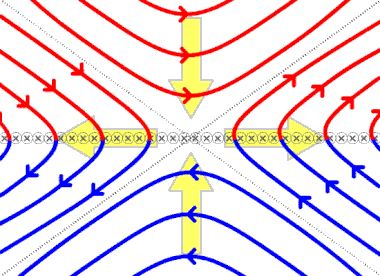
Back إعادة الاتصال المغناطيسي Arabic Reconnexió magnètica Catalan Rekonnexion German Reconexión magnética Spanish Magnetiline ümberühendumine Estonian Reconnexion magnétique French איחוי מגנטי HE Riconnessione magnetica Italian 磁気リコネクション Japanese 자기 재결합 Korean

Magnetic reconnection is a physical process occurring in electrically conducting plasmas, in which the magnetic topology is rearranged and magnetic energy is converted to kinetic energy, thermal energy, and particle acceleration.[4] Magnetic reconnection involves plasma flows at a substantial fraction of the Alfvén wave speed, which is the fundamental speed for mechanical information flow in a magnetized plasma.
The concept of magnetic reconnection was developed in parallel by researchers working in solar physics and in the interaction between the solar wind and magnetized planets. This reflects the bidirectional nature of reconnection, which can either disconnect formerly connected magnetic fields or connect formerly disconnected magnetic fields, depending on the circumstances.
Ron Giovanelli is credited with the first publication invoking magnetic energy release as a potential mechanism for particle acceleration in solar flares.[5] Giovanelli proposed in 1946 that solar flares stem from the energy obtained by charged particles influenced by induced electric fields within close proximity of sunspots.[6] In the years 1947-1948, he published more papers further developing the reconnection model of solar flares.[7] In these works, he proposed that the mechanism occurs at points of neutrality (weak or null magnetic field) within structured magnetic fields.
James Dungey is credited with first use of the term “magnetic reconnection” in his 1950 PhD thesis, to explain the coupling of mass, energy and momentum from the solar wind into Earth's magnetosphere. The concept was published for the first time in a seminal paper in 1961.[8] Dungey coined the term "reconnection" because he envisaged field lines and plasma moving together in an inflow toward a magnetic neutral point (2D) or line (3D), breaking apart and then rejoining again but with different magnetic field lines and plasma, in an outflow away from the magnetic neutral point or line.
In the meantime, the first theoretical framework of magnetic reconnection was established by Peter Sweet and Eugene Parker at a conference in 1956. Sweet pointed out that by pushing two plasmas with oppositely directed magnetic fields together, resistive diffusion is able to occur on a length scale much shorter than a typical equilibrium length scale.[9] Parker was in attendance at this conference and developed scaling relations for this model during his return travel.[10]
- ^ Øieroset, M.; et al. (2001-07-26). "In situ detection of collisionless reconnection in the Earth's magnetotail". Nature. 412 (6845): 414–417. Bibcode:2001Natur.412..414O. doi:10.1038/35086520. PMID 11473310. S2CID 4412119.
- ^ Boozer, Allen H. (2020-05-18). "Flattening of the tokamak current profile by a fast magnetic reconnection with implications for the solar corona". Physics of Plasmas. 27 (10): 102305. arXiv:2005.02285. Bibcode:2020PhPl...27j2305B. doi:10.1063/5.0014107. S2CID 218502561.
- ^ Zhu, Chunming; Liu, Rui; Alexander, David; McAteer, R. T. James (2016). "Observation of the Evolution of a Current Sheet in a Solar Flare". The Astrophysical Journal. 821 (2): L29. arXiv:1603.07062. Bibcode:2016ApJ...821L..29Z. doi:10.3847/2041-8205/821/2/L29. S2CID 119188103.
- ^ Mozer, Forrest S.; Pritchett, Philip L. (2010-06-01). "Magnetic field reconnection: A first-principles perspective". Physics Today. 63 (6): 34–39. doi:10.1063/1.3455250. ISSN 0031-9228.
- ^ Giovanelli, R. G. (July 1946). "A Theory of Chromospheric Flares". Nature. 158 (4003): 81–82. doi:10.1038/158081a0. ISSN 0028-0836. S2CID 4139384.
- ^ Giovanelli, R.G. (1947). "Magnetic and Electric Phenomena in the Sun's Atmosphere associated with Sunspots". Monthly Notices of the Royal Astronomical Society. 107 (4): 338–355.
- ^ Giovanelli, R. G. (1947-11-01). "Magnetic and Electric Phenomena in the Sun's Atmosphere associated with Sunspots". Monthly Notices of the Royal Astronomical Society. 107 (4): 338–355. doi:10.1093/mnras/107.4.338. ISSN 0035-8711.
- ^ Dungey, J. W. (1961-01-15). "Interplanetary Magnetic Field and the Auroral Zones". Physical Review Letters. 6 (2): 47–48. doi:10.1103/PhysRevLett.6.47. ISSN 0031-9007.
- ^ Sweet, P. A., The Neutral Point Theory of Solar Flares, in IAU Symposium 6, Electromagnetic Phenomena in Cosmical Physics, ed. B. Lehnert (Dordrecht: Kluwer), 123, 1958
- ^ Parker, E. N. (December 1957). "Sweet's mechanism for merging magnetic fields in conducting fluids". Journal of Geophysical Research. 62 (4): 509–520. doi:10.1029/JZ062i004p00509.